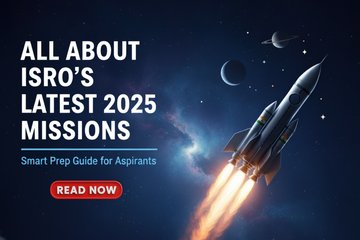India’s space programme moves fast – and 2025 was a busy year with several important launches, technological milestones, and programme updates that show how ISRO is deepening capabilities in Earth observation, navigation, lunar exploration, and crewed flight. If you’re studying for competitive exams (SSC, UPSC, state PSCs, GATE, or entrance tests with general-awareness sections), memorizing concise, high-value facts makes a big difference. Here’s a focused, exam-friendly guide to ISRO’s latest missions and milestones in 2025, why they matter, and exactly what to remember.
Quick snapshot — top ISRO facts from 2025
- PSLV-C61 / EOS-09 — An all-weather radar Earth-observation satellite launched on 18 May 2025 (PSLV-C61). Important for day/night, cloud-penetrating surveillance.
- GSLV-F15 / NVS-02 — Navigation satellite (NVS-02) launched 29 January 2025 aboard GSLV, strengthening India’s navigation constellation.
- Chandrayaan programme updates — Official Chandrayaan-3 mission resources and follow-on planning (data utilization calls and future sample-return ambitions) were active in 2025. Memorize Chandrayaan’s role: lander + rover demonstration, followed by sample-return and polar exploration collaboration (LUPEX).
- Gaganyaan budget & progress — India increased the Gaganyaan budget (reported Feb 2025) and completed key propulsion development work in 2025 as it progresses toward uncrewed and crewed test flights. Memorize the broad aim: develop crewed launch capability, test flights in the late 2020s.
- International collaborations — ISRO continues to host and launch international payloads (e.g., ESA’s Proba-3 on PSLV in late 2024) and to partner on large missions like NISAR (ISRO + NASA). NISAR was scheduled in 2025 (July launch noted in official listings).
What each mission is and why it matters?
EOS-09 (PSLV-C61) — launch and capability
- Launch date: 18 May 2025 (PSLV-C61).
- Payload type: All-weather Earth Observation Satellite with radar imaging (can see through clouds and at night).
- Why it’s important: Enhances India’s surveillance, disaster response, agriculture, and maritime monitoring capabilities; useful to mention in questions about remote sensing and strategic surveillance.
NVS-02 (GSLV-F15) — navigation strengthening
- Launch date: 29 January 2025 (GSLV-F15).
- Role: Navigation satellite to augment India’s Navigation Satellite System (helps positioning, timing, and navigation services).
- Exam angle: Tie to India’s self-reliance in GNSS services and applications in mobile navigation, defence, and civil services.
Chandrayaan programme — Chandrayaan-3 outcomes and next steps
- Chandrayaan-3 (lander + rover) was the demonstration of safe lunar landing and roving; ISRO published mission details and opened data utilisation calls in 2025.
- Follow-ons: Government approvals and collaborations pointed toward sample-return and polar exploration missions (LUPEX/Chandrayaan-4/Chandrayaan-5 planning mentioned in official and reputable summaries).
- Exam tip: Remember the sequence — Chandrayaan-1 (orbiter), Chandrayaan-2 (orbiter + lander failed to soft-land), Chandrayaan-3 (successful soft landing demonstration), then plans for sample-return/polar exploration.
Gaganyaan — human spaceflight program
- Budget & progress (2025): Reported budget increase and completion of key propulsion subsystem tests in early 2025; program aims for uncrewed test flights followed by crewed missions in the late 2020s.
- Why remember: Gaganyaan is India’s flagship crewed flight programme and often appears in questions about future space policy, national objectives, and technology demonstration. Key facts: Gaganyaan comprises uncrewed test missions (Vyommitra humanoid tests) followed by crewed flights; it also connects to plans for a national space station by the 2030s.
International & collaborative missions (Proba-3, NISAR)
- Proba-3 (ESA) launched on an ISRO PSLV (Dec 2024); demonstrates ISRO’s role as a global launch partner.
- NISAR (ISRO + NASA): A large, dual-frequency radar mission for land/ice deformation, ecosystems, and ocean monitoring — listed in ISRO schedules for 2025 (July noted). It’s a high-profile international collaboration.
Top 12 facts to memorize (flashcard style)
- EOS-09 — 18 May 2025, PSLV-C61, all-weather radar EO satellite.
- NVS-02 — 29 January 2025, GSLV-F15, navigation satellite.
- Chandrayaan-3 — mission details and science data utilisation opened in 2025; role: lunar soft-landing and rover.
- Gaganyaan budget increase reported in Feb 2025 (major policy development).
- ISRO hosted ESA’s Proba-3 on PSLV (Dec 2024 launch) — shows India’s commercial launch role.
- NISAR — joint ISRO-NASA mission (listed in 2025 schedule) for land and ice deformation studies.
- PSLV continues to be ISRO’s workhorse for small/medium satellites and international rideshares.
- GSLV is used for heavier, GTO-class payloads and navigation satellites (e.g., NVS-02).
- LUPEX / Chandrayaan sample-return plans involve international collaboration (Japan) for polar sampling.
- Vyommitra — humanoid robot to fly on uncrewed Gaganyaan test missions (keep as a concept to mention).
- ISRO’s mission numbering — PSLV/ GSLV launches are numbered (PSLV-C61, GSLV-F15) — exam questions sometimes ask mission labels.
- Announcement of Opportunity (AO) for Chandrayaan-3 data use indicates ISRO’s push to involve national researchers — good policy-level fact.
How to use this info in exams? — Strategy
- Prioritize dates + vehicles + objectives. Many MCQs ask “Which satellite was launched on X date?” or “Which launch vehicle was used?” So memorize the triplet: date — vehicle — payload objective (e.g., 18 May 2025 — PSLV-C61 — EOS-09 — radar Earth observation).
- Group by theme. Put Earth observation (EOS-09, NISAR), navigation (NVS-02), lunar (Chandrayaan-3 updates), and human spaceflight (Gaganyaan) into separate mental buckets. Exams often test theme recognition.
- Remember flagship programmes. Chandrayaan and Gaganyaan are perennial exam topics — know recent milestones (soft-landing demonstration, budget increases, and propulsion milestones).
- Use one-line sticky mnemonics. Example: “EON — EOS (Earth), NVS (Navigation), Gaganyaan (Orbiter/crew) for 2025” — short mnemonics help for last-minute revision.
Final checklist for last-minute revision
- Memorize the five most important 2025 items: EOS-09 (18 May), NVS-02 (29 Jan), Chandrayaan-3 data & follow-ups, Gaganyaan budget/progression, NISAR (ISRO-NASA).
- Know which launcher class is used for what (PSLV = EO & rideshares; GSLV = heavier comm/nav satellites; LVM3/GSLV for big payloads and crewed missions).
- Practice 10 one-line descriptions (date, vehicle, objective) until you can recall them in 10 seconds each.
Sources & further reading (official/reputable)
For accuracy and exam references, use ISRO’s official mission pages and major news outlets:
- ISRO official pages (Chandrayaan-3 details; Launch Missions list; Spacecraft Missions list).
- Reuters / Times of India coverage for Gaganyaan budget and propulsion milestones.
- Coverage of the EOS-09 / PSLV-C61 launch summarized by ISRO and national media.








vufo35
vufo35
lzyt8y